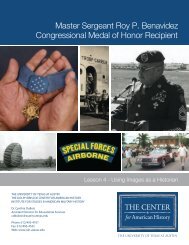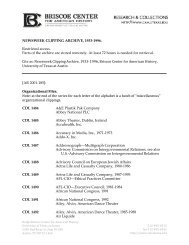Unit Overview - Center for American History - The University of ...
Unit Overview - Center for American History - The University of ...
Unit Overview - Center for American History - The University of ...
You also want an ePaper? Increase the reach of your titles
YUMPU automatically turns print PDFs into web optimized ePapers that Google loves.
Master Sergeant Roy P. BenavidezCongressional Medal <strong>of</strong> Honor Recipient<strong>Unit</strong> <strong>Overview</strong>THE UNIVERSITY OF TEXAS AT AUSTINTHE DOLPH BRISCOE CENTER FOR AMERICAN HISTORYINSTITUTE FOR STUDIES IN AMERICAN MILITARY HISTORYDr. Cynthia DuBoisAssistant Director <strong>for</strong> Educational Servicescddubois@austin.utexas.eduPhone: 512/495-4107Fax: 512/495-4542Web: www.cah.utexas.edu
<strong>The</strong> curriculum guide, MASTER SERGEANT ROY P. BENAVIDEZ:CONGRESSIONAL MEDAL OF HONOR RECIPIENT was createdcollaboratively by Dr. Cynthia DuBois, Assistant Director <strong>for</strong>Educational Services, and David Zepeda <strong>of</strong> the Institute <strong>for</strong> Studies in<strong>American</strong> Military <strong>History</strong> at the Dolph Briscoe <strong>Center</strong> <strong>for</strong> <strong>American</strong><strong>History</strong> at <strong>The</strong> <strong>University</strong> <strong>of</strong> Texas at Austin. We would like to thank:<strong>The</strong> Roy Benavidez family <strong>for</strong> their gift <strong>of</strong> Master SergeantBenavidez’s papers to the Dolph Briscoe <strong>Center</strong> <strong>for</strong> <strong>American</strong><strong>History</strong> and their continued support <strong>of</strong> the <strong>Center</strong>'s ef<strong>for</strong>ts toshare the legacy <strong>of</strong> Roy Benavidez with students and scholars.Chris Barbee, publisher <strong>of</strong> the El Campo Leader-News, <strong>for</strong> hisexpert and editorial help to guarantee the historical accuracy <strong>of</strong>the Benavidez curriculum guide.Maj. Darrell Debish, UT Army ROTC, <strong>for</strong> his expert help toguarantee the accuracy <strong>of</strong> the support material provided inthe guide.If you would like further in<strong>for</strong>mation about Master Sergeant Benavidezor to consult on an educational project with the Dolph Briscoe <strong>Center</strong><strong>for</strong> <strong>American</strong> <strong>History</strong> please contact:Dr. Cynthia DuBoisAssistant Director <strong>for</strong> Educational ServicesPhone: 512/495-4107 ~ 512-484-2339Fax: 512/495-4542Web: www.cah.utexas.eduE-mail: cddubois@austin.utexas.edu<strong>The</strong> Dolph Briscoe <strong>Center</strong> <strong>for</strong> <strong>American</strong> <strong>History</strong> ~ http://www.cah.utexas.edu/ 0.2
ROY P. BENAVIDEZCONGRESSIONAL MEDAL OF HONOR RECIPIENTTEACHER INTRODUCTION<strong>The</strong> purpose <strong>of</strong> this curriculum unit is to introduce students to M.Sgt. Roy P. Benavidez, a poor,undereducated, Mexican <strong>American</strong> from El Campo, Texas, who overcame many obstacles toachieve an outstanding career in the army. Through his heroic actions in the Vietnam War,Benavidez was awarded the Medal <strong>of</strong> Honor, the highest award given by the U.S. military.<strong>The</strong> unit was designed using a modified version <strong>of</strong> Understanding By Design by Wiggins andMcTighe. When a student finishes a lesson or the complete unit they should be able to answerwith authority the two Enduring Questions.1. What lessons can be learned from Roy Benavidez’s life story?2. What kinds <strong>of</strong> evidence does a historian use to help us understand the past?All the activities and evaluations are directed to this outcome.<strong>The</strong> unit can be used during Hispanic Heritage Month as a way to spotlight an outstanding rolemodel, as part <strong>of</strong> a Vietnam War teaching unit to make the war more personal, or to highlight aTexas hero.<strong>The</strong>re are five lessons. Each lesson stands alone and could be taught as a single introduction tothe topic. Lessons 3 and 4 teach the skills <strong>of</strong> working with primary sources using materials fromthe Roy P. Benavidez Papers located at the Dolph Briscoe <strong>Center</strong> <strong>for</strong> <strong>American</strong> <strong>History</strong> at <strong>The</strong><strong>University</strong> <strong>of</strong> Texas at Austin. If the first four lessons are taught it serves as a complete learningunit that sheds more light on Benavidez’s life and career.Lesson 5 allows the students to apply the skills taught while doing a research unit on anotherMedal <strong>of</strong> Honor recipient.All materials needed are included with each lesson plan in a downloadable <strong>for</strong>mat.LESSON SUMMARYLesson 1 is an introduction to the life <strong>of</strong> Master Sergeant Benavidez.Lesson 2 is a brief overview <strong>of</strong> the Vietnam War. <strong>The</strong> students use a timeline to reconstructBenavidez’s experience in the larger context <strong>of</strong> the Vietnam War.Lesson 3 teaches students to use the same process that historians use to evaluate primarysource documents.Lesson 4 teaches students to use the same process that historians use to evaluate primarysource photographs.Lesson 5 is a research project that provides an opportunity <strong>for</strong> students to apply the skills theyhave learned as they research the life <strong>of</strong> another Medal <strong>of</strong> Honor recipient.<strong>The</strong> Dolph Briscoe <strong>Center</strong> <strong>for</strong> <strong>American</strong> <strong>History</strong> ~ http://www.cah.utexas.edu/ 0.3
ROY P. BENAVIDEZCONGRESSIONAL MEDAL OF HONOR RECIPIENTTABLE OF CONTENTSA LESSON PLAN FOR MIDDLE SCHOOL AND HIGH SCHOOLTEKS – Texas Essential Knowledge and Skills 0.5 - 0.6Learning to Identify Primary and Secondary Sources 0.7 - 0.12Document and Photograph Credits 0.13Lesson 1 - IntroductionLesson In<strong>for</strong>mation 1.2 - 1.4Narrative 1.5 - 1.13Lesson Materials 1.14 - 1.17Supplemental Materials 1.18 - 1.22Lesson 2 - A Short Background Lesson on VietnamLesson In<strong>for</strong>mation 2.2 - 2.4Lesson Materials 2.5 - 2.16Lesson 3 - Identifying and Using Primary Source DocumentsLesson In<strong>for</strong>mation 3.2 - 3.4Lesson Materials 3.5 - 3.18Lesson 4 -Using Images as a HistorianLesson In<strong>for</strong>mation 4.2 - 4.4Lesson Materials 4.5 - 4.29Lesson 5 – Final ProjectLesson In<strong>for</strong>mation 5.2 - 5.2Lesson Materials 5.2 - 5.2<strong>The</strong> Dolph Briscoe <strong>Center</strong> <strong>for</strong> <strong>American</strong> <strong>History</strong> ~ http://www.cah.utexas.edu/ 0.4
ROY P. BENAVIDEZCONGRESSIONAL MEDAL OF HONOR RECIPIENTUNIT OVERVIEWTEKS – TEXAS ESSENTIAL KNOWLEDGE AND SKILLSSocial Studies, Grade 6.(a) Introduction.(2) To support the teaching <strong>of</strong> the essential knowledge and skills, the use <strong>of</strong> avariety <strong>of</strong> rich primary and secondary source material such as biographies andautobiographies; novels; speeches and letters; and poetry, songs, and artworksis encouraged. Selections may include Sadako and the Thousand Paper Cranes.Motivating resources are also available from museums, art galleries, andhistorical sites.Social Studies, Grade 7.(a) Introduction.(2) To support the teaching <strong>of</strong> the essential knowledge and skills, the use <strong>of</strong> avariety <strong>of</strong> rich primary and secondary source material such as biographies andautobiographies; novels; speeches, letters, and diaries; and poetry, songs, andartworks is encouraged. Selections may include a biography <strong>of</strong> Barbara Jordanor Lorenzo de Zavala and William B. Travis' letter "To the People <strong>of</strong> Texas andAll <strong>American</strong>s in the World." Motivating resources are also available frommuseums, historical sites, presidential libraries, and local and state preservationsocieties.(21) Social studies skills. <strong>The</strong> student applies critical-thinking skills to organize and usein<strong>for</strong>mation acquired from a variety <strong>of</strong> sources including electronic technology. <strong>The</strong>student is expected to:(A) Differentiate between, locate, and use primary and secondary sources suchas computer s<strong>of</strong>tware, databases, media and news services, biographies,interviews, and artifacts to acquire in<strong>for</strong>mation about Texas.(B) Analyze in<strong>for</strong>mation by sequencing, categorizing, identifying cause-and-effectrelationships, comparing, contrasting, finding the main idea, summarizing,making generalizations and predictions, and drawing inferences andconclusions.Social Studies, Grade 8.(a) Introduction.(2) To support the teaching <strong>of</strong> the essential knowledge and skills, the use <strong>of</strong> avariety <strong>of</strong> rich primary and secondary source material such as the complete text<strong>of</strong> the U.S. Constitution and the Declaration <strong>of</strong> Independence; landmark cases<strong>of</strong> the U.S. Supreme Court; biographies and autobiographies; novels; speeches,<strong>The</strong> <strong>Center</strong> <strong>for</strong> <strong>American</strong> <strong>History</strong> ~ http://www.cah.utexas.edu/ 0.5
ROY P. BENAVIDEZCONGRESSIONAL MEDAL OF HONOR RECIPIENTUNIT OVERVIEWletters, and diaries; and poetry, songs, and artworks is encouraged. Selectionsmay include excerpts from the letters <strong>of</strong> John and Abigail Adams, an excerpt fromthe Seneca Falls Declaration <strong>of</strong> Sentiments and Resolutions, and poems <strong>of</strong> theCivil War era. Motivating resources are also available from museums, historicalsites, presidential libraries, and local and state preservation societies.(24) Culture. <strong>The</strong> student understands the relationships between and among peoplefrom various groups, including racial, ethnic, and religious groups, during the 17th, 18th,and 19th centuries. <strong>The</strong> student is expected to:(D) Analyze the contributions <strong>of</strong> people <strong>of</strong> various racial, ethnic, and religiousgroups to our national identity.(30) Social studies skills. <strong>The</strong> student applies critical-thinking skills to organize and usein<strong>for</strong>mation acquired from a variety <strong>of</strong> sources including electronic technology. <strong>The</strong>student is expected to:(A) Differentiate between, locate, and use primary and secondary sources suchas computer s<strong>of</strong>tware, databases, media and news services, biographies,interviews, and artifacts to acquire in<strong>for</strong>mation about the <strong>Unit</strong>ed States.<strong>Unit</strong>ed States <strong>History</strong> Studies Since Reconstruction (High School)(b) Introduction.(2) To support the teaching <strong>of</strong> the essential knowledge and skills, the use <strong>of</strong> avariety <strong>of</strong> rich primary and secondary source material such as biographies andautobiographies; landmark cases <strong>of</strong> the U.S. Supreme Court; novels; speeches,letters, and diaries; and poetry, songs, and artworks is encouraged. Selectionsmay include a biography <strong>of</strong> Dwight Eisenhower, Upton Sinclair's <strong>The</strong> Jungle,and Martin Luther King's letter from the Birmingham City Jail. Motivatingresources are also available from museums, historical sites, presidentiallibraries, and local and state preservation societies.<strong>The</strong> Dolph Briscoe <strong>Center</strong> <strong>for</strong> <strong>American</strong> <strong>History</strong> ~ http://www.cah.utexas.edu/ 0.6
ROY P. BENAVIDEZCONGRESSIONAL MEDAL OF HONOR RECIPIENTUNIT OVERVIEWLEARNING TO IDENTIFY PRIMARY AND SECONDARY SOURCESMATERIALSHandouts:1 . Interactive notes <strong>for</strong> identifying primary and secondary source materials2 . Identifying primary and secondary sourcesExamples <strong>of</strong>:1 . A personal letter2 . A photograph3 . A business <strong>for</strong>m or document4 . Biographies and autobiographies checked out <strong>of</strong> the school library5 . Newspaper articlesOBJECTIVES<strong>The</strong> students will:1 . Define primary and secondary sources <strong>of</strong> in<strong>for</strong>mation2 . Examine samples <strong>of</strong> primary and secondary sources3 . Identify examples <strong>of</strong> primary and secondary sourcesANTICIPATORY SET (ATTENTION GETTER)<strong>The</strong> teacher will:1. Display examples <strong>of</strong> primary source documents included such as those listedin the materials section and copies <strong>of</strong> encyclopedias, textbooks, biographiesand autobiographies. Allow the students to walk around the display andexamine the materials.2. Introduce the lesson by asking:A. What can we learn by examining these different materials?B. How do you think historians use this kind <strong>of</strong> in<strong>for</strong>mation to write the historythat we read in our textbooks and other sources?C. How are the materials here different from each other?<strong>The</strong> Dolph Briscoe <strong>Center</strong> <strong>for</strong> <strong>American</strong> <strong>History</strong> ~ http://www.cah.utexas.edu/ 0.7
ROY P. BENAVIDEZCONGRESSIONAL MEDAL OF HONOR RECIPIENTUNIT OVERVIEW3. Say: “Our lesson today will focus on the different kinds <strong>of</strong> evidence thathistorians use to recreate historical periods. Those sources are broken intotwo categories: primary and secondary sources.PROCEDURE<strong>The</strong> teacher will:Guide the students through the interactive notes page on the definitions <strong>of</strong>primary and secondary sources.Guidelines <strong>for</strong> using interactive notes:1. Duplicate enough copies <strong>of</strong> the student worksheet.2. Using an overhead transparency <strong>of</strong> the teacher version <strong>of</strong> the interactivenotes, the teacher will guide the students through the notes by reading thenotes and writing the words that go in the blanks, allowing the students tocopy the correct words as they follow along. Only one line <strong>of</strong> print should beshown at one time to keep the students focused on the discussion. Whennotes are complete, the teacher asks students to read the notes aloud, andthe teacher answers any questions that students have about the notes.<strong>The</strong> students will:Examine the materials assembled <strong>for</strong> the lesson and complete a worksheetidentifying them as primary or secondary resources.CLOSURE<strong>The</strong> students will choose an item from the day’s lesson and explain whether it isa primary or secondary source and tell why.EVALUATION<strong>The</strong> teacher will grade the worksheet on completeness and accuracy. Rubricprovided.<strong>The</strong> Dolph Briscoe <strong>Center</strong> <strong>for</strong> <strong>American</strong> <strong>History</strong> ~ http://www.cah.utexas.edu/ 0.8
ROY P. BENAVIDEZCONGRESSIONAL MEDAL OF HONOR RECIPIENTUNIT OVERVIEWLearning to Identify Primary and Secondary SourcesPrimary sources are records <strong>of</strong> events as they are firstdescribed without anyone else’s interpretation (whatthey think it means) or analysis (taking it apart to findmeaning). <strong>The</strong>se items can be letters, photographs,maps, printed material such as newspapers, video andsound recordings, and physical objects such asclothing, furniture, or tools.Secondary sources <strong>of</strong>fer an analysis or an explanation<strong>of</strong> primary sources. Some secondary sources useprimary sources to support a certain opinion or idea.Examples <strong>of</strong> secondary sources are dictionaries,encyclopedias, textbooks, books, and articles.<strong>The</strong> Dolph Briscoe <strong>Center</strong> <strong>for</strong> <strong>American</strong> <strong>History</strong> ~ http://www.cah.utexas.edu/ 0.9
ROY P. BENAVIDEZCONGRESSIONAL MEDAL OF HONOR RECIPIENTUNIT OVERVIEWPrimary SourceSecondary SourceArt: Original artwork Magazine articledescribing the piece <strong>of</strong> art<strong>History</strong>: Original letter Biography about aperson’s life<strong>The</strong>ater: Videotape <strong>of</strong> aper<strong>for</strong>manceCritic’s review <strong>of</strong> theper<strong>for</strong>mance<strong>The</strong> Dolph Briscoe <strong>Center</strong> <strong>for</strong> <strong>American</strong> <strong>History</strong> ~ http://www.cah.utexas.edu/ 0.10
ROY P. BENAVIDEZCONGRESSIONAL MEDAL OF HONOR RECIPIENTUNIT OVERVIEWName:Date:Learning to Identify Primary and Secondary SourcesPrimary sources are _________________ <strong>of</strong> events as they are first describedwithout anyone else’s __________________ or__________________. <strong>The</strong>seitems can be letters, __________________, maps, printed material suchas_________________, video and sound recordings, and____________________ objects such as clothing, furniture, or tools.Secondary sources <strong>of</strong>fer an ____________________ or an explanation <strong>of</strong>primary sources. Some secondary sources use ____________________ sourcesto support a certain opinion or idea. ________________ <strong>of</strong> secondary sourcesare dictionaries, encyclopedias, __________________, books, and articles.Primary SourceSecondary SourceArt: ______________ artwork Magazine article describing ________<strong>History</strong>: Original _____________ Biography about a ____________ life<strong>The</strong>ater: Videotape <strong>of</strong> a ____________ Critic’s ___________ <strong>of</strong> the per<strong>for</strong>mance<strong>The</strong> Dolph Briscoe <strong>Center</strong> <strong>for</strong> <strong>American</strong> <strong>History</strong> ~ http://www.cah.utexas.edu/ 0.11
ROY P. BENAVIDEZCONGRESSIONAL MEDAL OF HONOR RECIPIENTUNIT OVERVIEWName:Date:Identifying Primary and Secondary SourcesStudent CopyExamine the documents your teacher has assembled <strong>for</strong> you and decide whetherthey are primary or secondary sources. Refer to your notes if you need them tohelp you make a decision. Your work will be graded on your accuracy andcompletion <strong>of</strong> the assignment.Primary Source DocumentsEvidenceSecondary Source DocumentsEvidence<strong>The</strong> Dolph Briscoe <strong>Center</strong> <strong>for</strong> <strong>American</strong> <strong>History</strong> ~ http://www.cah.utexas.edu/ 0.12
ROY P. BENAVIDEZCONGRESSIONAL MEDAL OF HONOR RECIPIENTUNIT OVERVIEWDocument and Photograph Credits<strong>The</strong> following items are selections from the Roy P. Benavidez Papers at the<strong>Center</strong> <strong>for</strong> <strong>American</strong> <strong>History</strong> at <strong>The</strong> <strong>University</strong> <strong>of</strong> Texas at Austin:1-1 Picture <strong>of</strong> Roy Benavidez1-A Benavidez in Germany, 19561-B Benavidez attempts to stop his parachute1-C Benavidez receiving the Medal <strong>of</strong> Honor1-D Benavidez’s funeral3-1 Pickle Letter3-2 Enlisted Efficiency Report3-3 Tobias Letter3-4 DD-214 document4-1 Benavidez squatting on ground4-2 Benavidez in paratrooper training4-3 Benavidez receiving the Medal <strong>of</strong> Honor4-4 Hispanic Medal <strong>of</strong> Honor recipients4-5 Benavidez at podium4-6 Benavidez throwing baseball4-7 Benavidez’s funeral4-8 Benavidez’s headstone at Fort Sam Houston<strong>The</strong> following items are selections from Wally McNamee Photographic Archive,ca. 1955-2000, at the Dolph Briscoe <strong>Center</strong> <strong>for</strong> <strong>American</strong> <strong>History</strong> at <strong>The</strong><strong>University</strong> <strong>of</strong> Texas at Austin:1-A Choppers fly over area near Saigon2-1 Choppers fly over area near Saigon4-9 Patrol crossing stream<strong>The</strong> Dolph Briscoe <strong>Center</strong> <strong>for</strong> <strong>American</strong> <strong>History</strong> ~ http://www.cah.utexas.edu/ 0.13


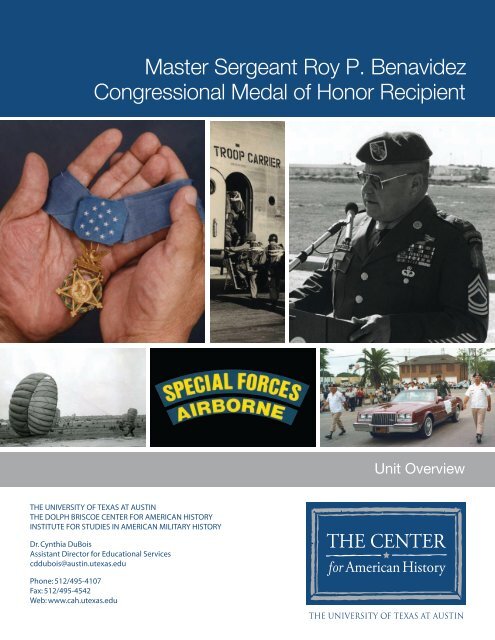
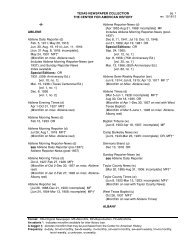
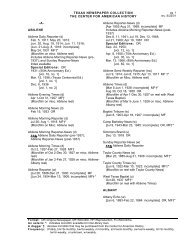
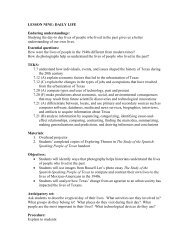
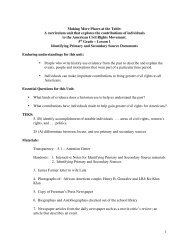

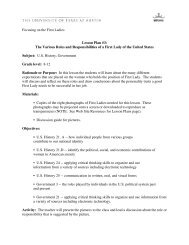

![[Cross] List of citizens who are going out to their ranchos to get cattle ...](https://img.yumpu.com/42850302/1/190x252/cross-list-of-citizens-who-are-going-out-to-their-ranchos-to-get-cattle-.jpg?quality=85)


